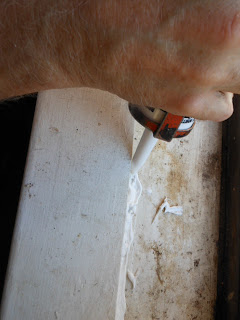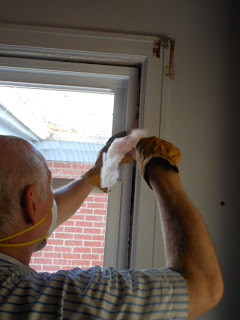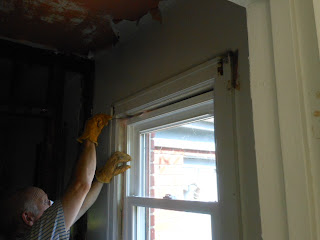With the window out and the area cleaned up, it's time to prepare the new unit and put it in.
First, unpack the new window. Some suppliers have them shrink-wrapped or otherwise protected. All this has to be removed. On vinyl windows there is a movable trim piece on top that can be adjusted to fit the opening better, and sometimes the manufacturer packs other things under there. Mine had a trim piece for the bottom outside of the window to cover the gap caused by the slope in the sill. Some may put a package of screws for fastening the window in place (this one had the screws packed with the instructions, between the lower sash and the screen). While you still have it out, look for the holes the manufacturer provided for the installation screws; this window has 4 on each side. Vinyl windows have the two sashes, set in a vinyl frame with the spring balances in place, ready to go, usually with a screen on the outside surface.
 |
| Next thing is a trial fit. |
 |
Pick it up, line it up and set it in the space and see how it fits. |
 |
| After seeing this, I
chose to put the top trim back on. Then take the window back out. Cut
the bottom trim for the outside to the width you need with snips and
install it. |
 |
Before installing the window for keeps, put a bead of caulk on the blind stops |












This is a good, clear and comprehensive window installation guide. I’m sure many homeowners, especially DIY-ers, will find this very useful. But if the task proves to be a mountain of a challenge, it’s always best to seek the services of a professional for an effective and foolproof window installation.
ReplyDeleteKatie Nicoll
Katie, doing something like this isn't for everybody. I started out as a DIY-er back in the late '70s with our first house, then ended up a contractor doing mostly remodeling, and some new construction. Over the years, there are very few jobs on a house that I haven't done (some of them I would rather not do again). But very little of the work on a house is any kind of rocket science--if it was, most of the guys I have worked with over the last 30 years wouldn't have been in it. On most things, the information is out there, if a person will take the trouble to look. I learned a lot from books, from magazines, from other people, and now the Internet. There are some things (wiring is a major one), where it is essential that you pay attention to small details; a person who can't do that had better hire the work. But on the other end of the scale, in some situations "professional" only means the guy found somebody to pay him for doing it. I have seen good and bad DIY-ers, and good and bad contractors. Even if you don't do it yourself, if you know more about the project, you're less likely to get stuck with a shoddy job.
ReplyDeleteThanks so much for sharing this. I looking to get some window installation in NJ done on my house. I am not that handy so I'll need all of the help that I can get.
ReplyDeleteBasic or not, the way you showed us how to install the window made it so easy for us to understand. Windows are truly essential to have as part of the house.
ReplyDelete- DryTechRoofingCompany.com
There are lots of considerations that you must take in before starting. Things like window measurements, tools to use, safety gloves, and more. Also, skills are essential in this part because removing and installing window frames is quite hard.
ReplyDelete- KrollWindow.com